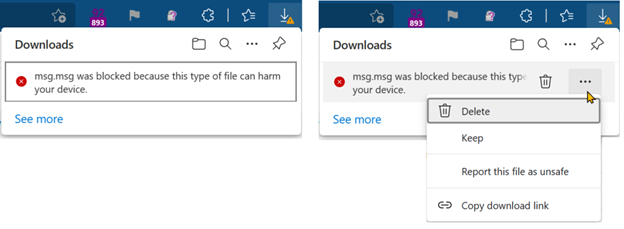Identify and interrupt downloads of potentially dangerous files
Microsoft Edge's File Type Policies component classifies files by their level of "dangerousness" to manage file downloads. A harmless file (for example, a .txt file) can be downloaded freely, while a potentially dangerous file like a .dll is subjected to a higher degree of vetting. This scrutiny provides a more security-conscious user experience.
How Microsoft Edge determines the danger level of a file type
Microsoft Edge inherits most of its file type policies from the upstream Chromium browser, with a few changes for security or compatibility reasons. You can view Chromium's policies for file types and their classification in the download_file_types.asciipb file. In this file, you'll see that each type has a danger_level, which is one of three values: DANGEROUS, NOT_DANGEROUS, or ALLOW_ON_USER_GESTURE.
The following two classifications are simple:
- NOT_DANGEROUS means that the file is safe to download, even if the download request was accidental.
- DANGEROUS means that the browser should always warn the user that the download may harm their device.
The third setting, ALLOW_ON_USER_GESTURE is more subtle. These files are potentially dangerous, but most likely harmless if the user requests the download. Microsoft Edge will allow these downloads to continue automatically if two conditions are both met:
- There's a user gesture associated with the network request that started the download. For example, the user clicked a link to the download.
- There's a recorded prior visit to the referring origin (the page that links to the download) before the most recent midnight (that is, yesterday or earlier). This recorded visit implies that the user has a history of visiting the site.
The download will also continue automatically if the user explicitly starts it by using the Save link as context menu command, enters the download's URL directly into the browser's address bar, or if Microsoft Defender SmartScreen indicates that the file is safe.
Note
Starting in version 91, Microsoft Edge will interrupt downloads that lack the required gesture.
User experience for downloads that lack a gesture
If a download for a potentially dangerous type starts without the required gesture, Microsoft Edge states that the download "was blocked". Commands named Keep and Delete are available from the … (ellipsis) option on the download item to let the user continue or cancel the download.

On the edge://downloads page, the user will see the same options. The next screenshot shows and example of these options.

Enterprise controls for downloads
While users are unlikely to encounter download interruptions for sites they use every day, they might encounter them for legitimate downloads on sites that they use rarely. To help streamline the user-experience for Enterprises, a Group Policy is available.
Enterprises can use ExemptFileTypeDownloadWarnings to specify the filetypes that are allowed to download from specific sites without interruption. For example, the following policy allows XML files to download from contoso.com and woodgrovebank.com without interruption, and allows MSG files to download from any site.
[{"file_extension":"xml","domains":["contoso.com", "woodgrovebank.com"]}, {"file_extension":"msg", "domains": ["*"]}]
File types requiring a gesture
Chromium's latest file types policies are published in the Chromium source code, and Microsoft Edge inherits most of these, with a few changes for security or compatibility reasons. As of May 2021, file types with a danger_level of ALLOW_ON_USER_GESTURE on at least one OS platform include:
crx, pl, py, pyc, pyo, pyw, rb, efi, oxt, msi, msp, mst, ade, adp, mad, maf, mag, mam, maq, mar, mas, mat, mav, maw, mda, mdb, mde, mdt, mdw, mdz, accdb, accde, accdr, accda, ocx, ops, paf, pcd, pif, plg, prf, prg, pst, cpi, partial, xrm-ms, rels, svg, xml, xsl, xsd, ps1, ps1xml, ps2, ps2xml, psc1, psc2, js, jse, vb, vbe, vbs, vbscript, ws, wsc, wsf, wsh, msh, msh1, msh2, mshxml, msh1xml, msh2xml, ad, app, application, appref-ms, asp, asx, bas, bat, chi, chm, cmd, com, cpl, crt, cer, der, eml, exe, fon, fxp, hlp, htt, inf, ins, inx, isu, isp, job, lnk, mau, mht, mhtml, mmc, msc, msg, reg, rgs, scr, sct, search-ms, settingcontent-ms, shb, shs, slk, u3p, vdx, vsx, vtx, vsdx, vssx, vstx, vsdm, vssm, vstm, vsd, vsmacros, vss, vst, vsw, xnk, cdr, dart, dc42, diskcopy42, dmg, dmgpart, dvdr, dylib, img, imgpart, ndif, service, smi, sparsebundle, sparseimage, toast, udif, action, definition, wflow, caction, as, cpgz, command, mpkg, pax, workflow, xip, mobileconfig, configprofile, internetconnect, networkconnect, pkg, deb, pet, pup, rpm, slp, out, run, bash, csh, ksh, sh, shar, tcsh, desktop, dex, apk, rdp
The file type danger level may vary by operating system
File type settings sometimes vary depending on the client OS platform. For instance, an .exe file isn't dangerous on a Mac, while an .applescript file is harmless on Windows.